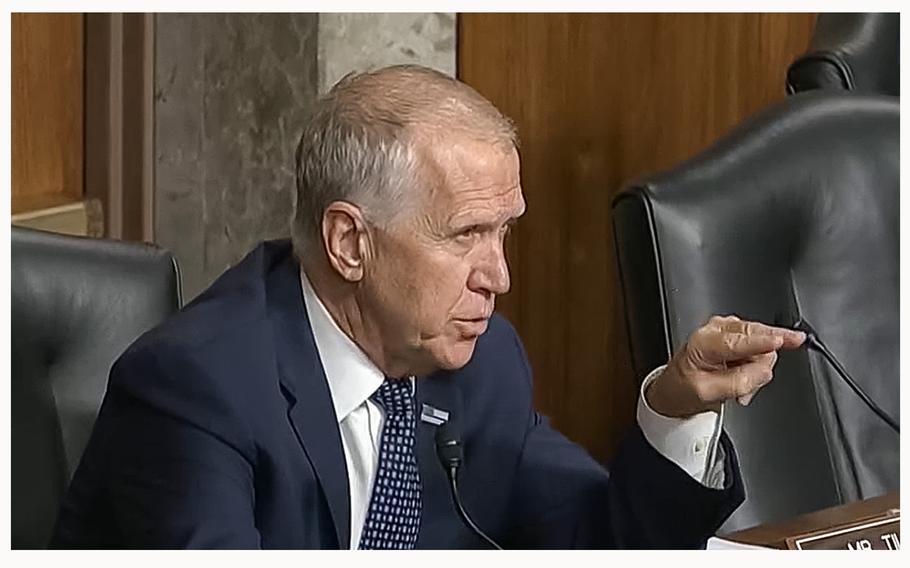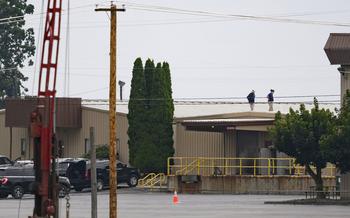
A video screen grab shows Sen. Thom Tillis asking questions on Tuesday, July 30, 2024, during a Senate hearing on Capitol Hill in Washington, D.C., concerning the July 13 assassination attempt on former President Donald Trump. (C-Span)
WASHINGTON (Tribune News Service) — Sen. Thom Tillis narrowed his focus to a 30-second time frame during the July 13 rally in Butler, Pa., where former President Donald Trump was giving a speech.
He was listening Tuesday morning in a Senate hearing to testimony — which included a timeline of events from the attempted assassination on Trump in Butler — from both Ronald Rowe Jr., acting director of the Secret Service, and Paul Abbate, deputy director of the FBI.
Seventeen days earlier, a gunman identified by law enforcement as Thomas Matthew Crooks, 20, shot at Trump and in the process killed a retired firefighter and seriously injured two others.
In the two weeks since, members of Congress and the public have learned local law enforcement had been suspicious of Crooks and that two officers had followed him to a building’s roof where he positioned himself to shoot at Trump. One officer hoisted the other onto his shoulders to get a look over the roofline and found Crooks pointing his gun back at him.
“What actually happened in the 30 seconds where a law enforcement officer knew that a gun was pointed in the direction of the president from a fairly short range?” Tillis asked. “What actually did those folks who did have knowledge of exactly what was happening and could probably infer with what was about to happen, what did they do?”
Abbate told the North Carolina Republican that after the officer jumped down to avoid being shot, Butler County law enforcement and Pennsylvania State Police began to react.
Tillis cut off the testimony, saying there was a clear operational problem because there was enough time to get word to the counter snipers of a problem.
In earlier testimony during the hearing, senators learned that even though local law enforcement knew Crooks had a gun, that information never made it to federal officers.
“I love law enforcement,” Tillis said. “I wear the “Back the Blue” pin every day. They do great work. The Secret Service did phenomenal work on the stage. But they failed, because their job is to protect the public, and they needed to put themselves in harm’s way to stop him.”
Tillis was one of nine senators to immediately request Senate Judiciary Committee Chairman Dick Durbin hold a hearing regarding the events that led to the attempted assassination of Trump.
The Judiciary Committee and the Senate Homeland Security and Government Affairs Committee held the hearing together Tuesday morning. It was the first public hearing for senators, though a classified briefing had previously been held.

Two FBI investigators on July 14, 2024, in Butler, Pa., scan the roof of AGR International Inc, the building adjacent to the Butler Fairgrounds, from which Matthew Thomas Crooks fired, in an attempted assassination, at former President Donald Trump during a campaign rally on July 13. (Jeff Swensen, Getty Images/TNS)
Abbate also provided a detailed timeline of what they’ve learned about Crooks’ and law enforcement’s actions leading up to the shooting. Here is the timeline as described by Abbate.
July 3: The Trump rally is publicly announced.
July 6: Crooks registers to attend the rally. He searches for how far Lee Harvey Oswald was from President John F. Kennedy when Kennedy was assassinated.
July 7: Crooks travels to the Butler Farm Show, the site of the rally, where he spends 20 minutes.
July 12: Crooks practices shooting at the Clairton Sportsmen’s Club.
July 13
10 a.m: Crooks returns to Butler Farm Show and stays for 70 minutes.
1:30 p.m: Crooks returns home and gets a rifle from his father, who believes Crooks is going to the sportsmen’s club.
1:55 p.m: Crooks buys ammunition on his way to the Butler Farm Show.
3:51 p.m: Crooks flies a drone 200 yards from the Butler Farm Show.
4:26 p.m: Crooks is spotted by local law enforcement.
5:10 pm: Crooks is spotted again and identified as suspicious.
5:14 p.m: A local SWAT team member takes a photo of Crooks.
5:32 p.m: Crooks is spotted while using a rangefinder.
5:38 p.m: The photo of Crooks is sent to local SWAT team members.
5:46 p.m: The Secret Service Command Post is notified of a suspicious person.
6:02-6:08 p.m. Local law enforcement lose sight of Crooks.
6:06 p.m: A local business’s camera shows Crooks pulling himself onto the roof.
6:08 p.m: Local law enforcement sees Crooks on the roof.
6:11 p.m: An officer hoists a second officer onto his shoulders to see onto the roof and radios to local police that Crooks is armed.
Within 30 seconds, shots are fired.
Tillis called the event “a massive failure.”
“There were at least two law enforcement officers that knew a guy was about to pull the trigger at the president and I’m just not really happy with the fact that we could have communicated: ‘Cover President Trump and try to secure the situation.’ I’m going to let the investigation go forward, but I think it’s very important to point out that we can’t let a scenario go in the future where 20 seconds can lapse when a law enforcement officer within two football fields of a former president of the United States has material knowledge that somebody is about to get shot at on stage, and we don’t have instantaneous response.”
Tillis cautioned his colleagues from believing that Rowe and Abbate had not been forthcoming in their testimony, saying that anybody who believes that local law enforcement don’t have problems with communications needs to spend some time in local government.
Tillis asked Rowe about any obstructions the Secret Service snipers had that prevented them from seeing Crooks. He said a tree blocked the view from the counter snipers on stage right.
Tillis said he doesn’t believe reports that the sniper saw Crooks 20 minutes prior to the shooting.
“It sounds like the one who took the shot probably saw him for the first time about a split second before he pulled the trigger,” Tillis said, asking for confirmation.
“That’s my assessment, Senator,” Rowe said.
Tillis also requested that Rowe provide the two committees with data from Nov. 5, 2022, the day Trump announced his reelection campaign, through the shooting, of every time Trump requested additional security and whether that request was fulfilled, denied or downsized.
Both men also promised that their agencies are working to secure the Democratic National Convention slated to begin on Aug. 19. The shooting took place just two days before the start of the Republican National Convention, which already had increased security due to the country’s political climate.
“We’ve been working on this for well over a year in preparation,” Abbate said.
©2024 McClatchy Washington Bureau.
Visit mcclatchydc.com
Distributed by Tribune Content Agency, LLC.